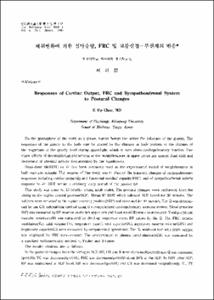체위변화에 의한 심박출량, FRC 및 교감신경 - 부신계의 반응
- Keimyung Author(s)
- Chae, E Up
- Department
- Dept. of Physiology (생리학)
- Journal Title
- Keimyung Medical Journal
- Issued Date
- 1990
- Volume
- 9
- Issue
- 1
- Abstract
- On the gravisphere of the earth as a planet, human beings live under the influence of the gravity. The respones of the gravity to the body may be altered by the changes in bldy position or the changes of the magnitude of the gravity itself during spaceflight, which in turn alters cardiopulmonary function. Two major effects of deconditioning phenomena in the weightlessness in space crews are central fluid shift and decrement of physical activity demonstrated by the hypokinesia. Head-down tilt(HDT) to -6˚ has been commonly used as the experimental model of weightlessness in both man and animals. The purpose of this study was to observe the transient changes of cardiopulmonary responses including cardiac output(Q) and functional residual capacity(FRC), and of sympathoadrenal activity response to -6˚HDT within a relatively early period of the passive tilt. This study was done on 10 healthy young adult males. The postural changes were perform the sitting to the supine control position(SCP). Minus 6˚ HDT which followed SCP lasted for 30 minutes. The subjects were returned to the supine recovery position(SRP) and remained for 10 minutes. The Q was determined by the CO₂rebreathing method using the computerized cardiopulmonary exercise systm. Blood pressure (BP) was measured by BP monitor on the left upper arm and heart rate(HR) was also measured. Total peripheral vascular resistance(R) was calculated by dividing respective mean BP values by the Q. The FRC, minute ventilation(??), tidal volume(TV), respiratour rate(f), vital capacity(VC), expiratory reserve volume(ERV) and was inspiratory capacity(IC) were measured by computerixed spirometer. The N₂wash-out test with 100% oxygen was employed for FRC measurement. The concentration of plasma catecholamines(CA) was measured by a modified radioenzymatic method of Peuler and Johnson. The results obtained are as follows: In the postural changes from the sitting to SCP, BP, HR and R were decreased(p<0.01) and Q was increased (p<0.05). VC was decreased(p<0.01). FRC was decreased(p<0.01) about 26% at the SCP. In HDT after SCP, BP was maintained at SCP level. HR was decreased(P<0.01) and CA was decreased insignificantly. V? TV and VC were decreased(P<0.05). FRC was declined about 3% in HDT than that of SCP. In SRP, Q was decreased(p<0.05), and BP, R and HR were increased, in comparison with the values at 30 minutes of FDT. TV was also increased(p<0.05). From the above results, it may be suggested that depressor reflex causing the decrease of R, HR and CA during FDT, and pressor reflex causing the increase of R and HR during SRP, are triggered by the cardiopulmonary baroreceptors.
- Alternative Title
- Responses of Cardiac Output, FRC and Sympathoadrenal System to Postural Changes
- Keimyung Author(s)(Kor)
- 채의업
- Publisher
- Keimyung University School of Medicine
- Citation
- 채의업. (1990). 체위변화에 의한 심박출량, FRC 및 교감신경 - 부신계의 반응. Keimyung Medical Journal, 9(1), 51–60.
- Type
- Article
- Appears in Collections:
- 2. Keimyung Medical Journal (계명의대 학술지) > 1990
1. School of Medicine (의과대학) > Dept. of Physiology (생리학)
Items in Repository are protected by copyright, with all rights reserved, unless otherwise indicated.
